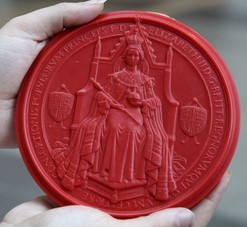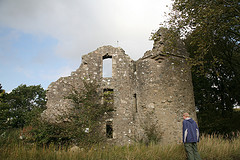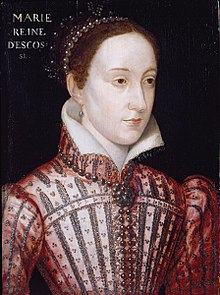Year 1489 (MCDLXXXIX) was a common year starting on Thursday of the Julian calendar.

Lord Gray is a title in the Peerage of Scotland. The Barony of Gray was created circa July 1445 for the Scottish diplomat and politician Sir Andrew Gray. The first Lord Gray was a hostage in England for the good conduct of James I of Scotland from 1424 to 1427, and was one of the knights who accompanied Lady Margaret Stewart to France for her marriage to Louis XI of France in 1436.

The Great Seal of Scotland is a principal national symbol of Scotland that allows the monarch to authorise official documents without having to sign each document individually. Wax is melted in a metal mould or matrix and impressed into a wax figure that is attached by cord or ribbon to documents that the monarch wishes to make official. The earliest seal impression, in the Treasury of Durham Cathedral, is believed to be the Great Seal of Duncan II and dates to 1094.
The Armour-Bearer was one of the Great Offices of the Royal Household in Scotland.

Lord Oliphant was a title in the Peerage of Scotland. It was created twice and de facto under Peerage Law a third time. The first creation is in abeyance of the law, the second extinct and the third creation is dormant.

Balvaird Castle in Perthshire is a traditional late medieval Scottish tower house. It is located in the Ochil Hills, around 5 kilometres (3.1 mi) south of Abernethy. The name Balvaird is from Baile a' Bhàird, 'Township of the Bard' in Gaelic. Balvaird Castle is a scheduled monument, and is in the care of Historic Environment Scotland. The spelling of its name has many variations, including Balverd, Balverde, Balward, Balwaird and Baleward.
The personal name Duncan can be found in Scotland’s oldest records in its Gaelic form Dunchad/Donchadh/Donachie/Donnchadh and other spelling variants.
Mairead inghean Eachainn, also known as Mairead nic Eachainn, was a consort of Alexander Stewart, Earl of Buchan. She was the daughter of a man named Eachann, and probably the mother of several children, including Alexander's like-named son, Alexander Stewart, Earl of Mar.
A feudal lordship is a feudal title that is held in baroneum, which Latin term means that its holder, who is called a feudal lord, is also always a feudal baron. A feudal lordship is an ancient title of nobility. The holder may or may not be a Lord of Regality, which meant that the holder was appointed by the Crown and had the power of "pit and gallows", meaning the power to authorise the death sentence.

Sir William Borthwick, 3rd of Borthwick and later 1st Lord Borthwick was a Scottish peer and ambassador.
Plenderleith is a Scottish feudal Crown barony comprising approximately one half of Oxnam Parish, Roxburghshire, in the vicinity of Kelso, Scottish Borders. The earliest references to the estates of Plenderleith date to 1175, when John de Plenderleith witnessed a charter in lands in Teviotdale during the reign of William the Lion. By the mid-13th century, the lands of Plenderleith were held by Nicholas de Prendrelathe, lay abbott of Jedburgh Abbey. In 1292, the estates passed to his daughter, Johanna, the wife of Sir John Wishart (Wishard/Wischarde/Whyssard/Wyssard).

Esslemont Castle is a ruined tower house in Aberdeenshire, Scotland. It is located on the A920 west of Ellon and is designated a scheduled ancient monument.
William Douglas of Cluny was a Scottish noble who was a guardian to King James III of Scotland and in 1464, Warden of the Eastern and Middle Marches.
A feudal earldom is a Scottish feudal title that is held en baroneum, which means that its holder, who is called a feudal earl, is also always a feudal baron. A feudal earldom is an ancient title of nobility in Scotland. The holder may or may not be a Lord of Regality, which meant that the holder was appointed by the Crown and had the power of "pit and gallows", meaning the power to authorise the death sentence. A feudal earl ranks above a feudal lord and a feudal baron, but below an earldom which is a title in the Peerage of Scotland. Feudal earldoms are very rare. As well, due to rights granted from ancient Scots law, in a very few instances, the holder of a feudal earldom may be different than the holder of a peerage title of the same name. A peer is invariably addressed as 'Lord Placename' or 'Lord Such-and-so', whilst those holding a feudal earldom are addressed 'Earl of Placename'. Scottish titles, in order of precedence, are as follows: Duke, Marquis, Earl, Viscount, Lord, Baronet, Knight, feudal Baron, Clan Chief, Esquire/Gentleman. Wallace states that "Lordships, Earldoms, Marquisates and Dukedoms differ only in name from Baronies" but continues "one whose property was erected into a Lordship ranked before a simple Baron" and "A person to whom an Earldom belonged, would be superior to a person who had no more than a lordship ... One, whose lands were incorporated into a Marquisate, was superior to both ... A man, who owned a fief elevated into a Dukedom, was exulted above all three." However, Lord Stair states that Lordships or Earldoms are "but more noble titles of a Barony".
Leswalt is a village and civil parish in Dumfries and Galloway, south-west Scotland. It lies between Portpatrick and Stranraer in the Rhins of Galloway, part of the traditional county of Wigtownshire. The parish covers around 8 square miles (21 km2).

The Barony of Craigie is a Scottish feudal Crown barony within and near Dundee in Scotland. Craigie has long been incorporated within the boundaries of the Royal Burgh of Dundee; before that it was a barony lying on the periphery of the town.
Penninghame in Wigtownshire, Dumfries and Galloway, Scotland, is a civil parish area, 8 miles from Wigtown. The area is approx 16 miles in length, and from 5 to 6 miles' width, bounded on the north and east by the River Cree, and on the west by the Bladnoch; comprising nearly 38,000 acres, of which 12,000 were arable, 600 woodland and plantations, 1600 meadow, and the remainder hill pasture, moorland, moss, etc.
The Barony of Grougar is a Scottish feudal barony which lies in north Ayrshire in the district formerly known as Cunninghame. The earliest known family likely to have owned Grougar were the De Morvilles who were there in the twelfth and thirteenth centuries before the reign of Robert the Bruce. The De Morvilles originated in Morville, Department of Manche, Normandy, arrived in England in the wake of the Norman Conquest, settled in Burg, Cumbria, and later moved to Scotland in the early 12th century where they were granted land in Ayrshire. This land grant precedes the establishment of the Register of the Great Seal of Scotland so cannot be positively confirmed. Hugo de Morville who died in 1202 was the Constable of Scotland. By the late thirteenth century the Logan family were barons of Grougar. Thorbrand de Logan baron of Grougar is recorded in 1272 and a John de Logan of Grugar may be the John Logan described as ‘one of the king of England's enemies’ in 1307 during the Wars of Independence.
The Lordship and Barony of Balvaird is a Scottish feudal lordship. The caput of the Lordship and Barony of Balvaird is Balvaird Castle, in the County of Perthshire in Scotland. One of the borders of the Barony was at one time the River Farg. The Barony was originally granted by a Crown Charter of Confirmation in favour of Lord Andrew Murray "of the lands and Barony of Balvaird" dated 16 March 1624. The Barony is described in Latin in the crown grant as "terrarum et baronie de Balvaird". The spelling of the name of the Lordship & Barony has many variations, including Balverd, Balverde, Balward, Balwaird and Baleward.
Elizabeth Bruce was a daughter of King Robert the Bruce and was married to Sir Walter Oliphant (Olifaunt) of Aberdalgie and Dupplin.











